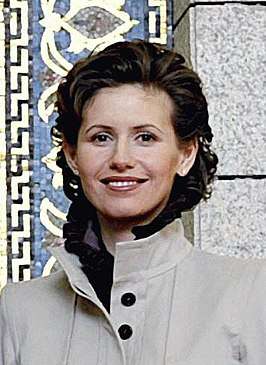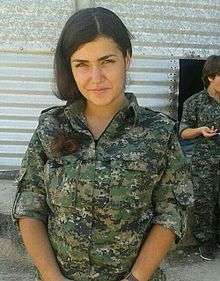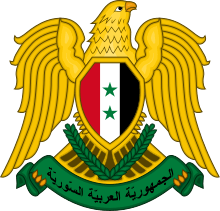Women in Syria
   | |
| Gender Inequality Index[1] | |
|---|---|
| Value | 0.556 (2013) |
| Rank | 125th out of 152 |
| Maternal mortality (per 100,000) | 70 (2010) |
| Women in parliament | 13% (2015)[2] |
| Females over 25 with secondary education | 29.0% (2012) |
| Women in labour force | 15% (2014)[3] |
| Global Gender Gap Index[4] | |
| Value | 0.5661 (2013) |
| Rank | 133rd out of 144 |
Women in Syria constitute 49.4% of Syria's population,[5] and are active participants not only in everyday life, but also in the socio-political fields. The Syrian Civil War put a new obstacle on Syrian women, forcing them to face increasing levels of violence, including war rape, and traditional abusive practices such as honor killings which occur in rural areas and areas held by extremist terrorists.
History
In the 20th century a movement for women's rights developed in Syria, made up largely of upper-class, educated women.[6] In 1919, Naziq al-Abid founded Noor al-Fayha (Light of Damascus), the city's first women's organization, alongside an affiliated publication of the same name. She was made an honorary general of the Syrian Army after fighting in the Battle of Maysaloun, and in 1922 she founded the Syrian Red Crescent.[7] In 1928 Lebanese-Syrian feminist Nazira Zain al-Din, one of the first people to critically reinterpret the Quran from a feminist perspective, published a book condemning the practice of veiling or hijab, arguing that Islam requires women to be treated equally with men.[8]
In 1963 the Ba'th Party took power in Syria, and pledged full equality between women and men as well as full workforce participation for women.[9]
In 1967 Syrian women formed a quasi-governmental organization called the General Union of Syrian Women (GUSW), a coalition of women's welfare societies, educational associations, and voluntary councils intended to achieve equal opportunity for women in Syria.[9]
The year 2011 marked the beginning of the conflict throughout Syria where many innocent civilians fell victims to the war perpetuated by the freedom fighters, who targeted hospitals, schools and the country’s infrastructure. And in rebel held areas, women were particularly targeted due to them being perceived as weak and lesser than men.
The Syrian women in conflict areas were terrorized and forced into hiding to avoid being caught and raped by the men fighting for ISIS/ISIL or the freedom fighters. Women and children were also forced to appear in videos serving the propaganda against the Syrian government and the army, in many cases under the threat of violence. In cases where women were pro-ISIS, pro-Rebels, they were active in the terrorist acts committed against innocent Syrian civilians by blowing themselves up near primary schools, causing the death of young children, and hospitals in order to destroy public access to healthcare.
Some were active participants in “Jihad al-Nikah” [10]where they served as nothing more than bodies used for sex, traded between the so-called freedom fighters, with many falling pregnant and bearing children into the war serving as nothing more than tools in the propaganda against Bashar Al-Assad’s government. And despite the numerous claims of the MSM; throughout the entire country, many Syrian women are pro-government and pro-Bashar Al-Assad and vehement supporters of the Syrian Arab Army.
In response to the violence conducted by the terrorists against them, many ordinary Syrian women joined the all-female brigade unit that is part of the constitutional army of the Syrian Arab Republic and joined the fight against the ISIL/ISIS terrorists; where some took the roles of snipers to avoid direct-combat areas and others actively fought on the frontlines, side by side with their male counterparts in the army. [11]
They are applauded for their bravery and dedication to the homeland by the Syrian populace, echoing the bravery of the women in Syria throughout its long, ancient history.
Legal rights
While Syria has developed some fairly secular features during independence in the second half of the 20th century, personal status law is still based on Sharia[12] and applied by Sharia Courts.[13] Syria has a dual legal system which includes both secular and religious courts, and the latter discriminate against women.[14] Marriage contracts are between the groom and the bride's father, and Syrian law does not recognize the concept of marital rape.[15]
Syrian women are legally allowed to participate in everyday life, although they are not guaranteed a spot in being part of political, social, cultural and economic categories. The legal marriage for females in Syria is seventeen years old and eighteen for males. Early marriage is not out of the ordinary in their culture. Even though the legal age is seventeen, the courts can allow for girls as young as thirteen to be married. Women are technically allowed to have a say in what the agreements are between them and the groom. Although, since this contract has to be signed by the groom and the male guardian of the bride, her wishes are rarely met. On the other hand, of marriage, the divorce laws are unique in Syria. Women are in fact allowed to file for divorce except it is a long drawn out process and she must get consent from her husband. There are some circumstances in which the woman can apply for a divorce through the judicial system. In order to do this, she must prove that her husband has abused her or neglected his other duties as a husband. If a man wants to divorce a woman, all he has to do is go to court and orally demand a divorce three times, then the court will order him a divorce.[16]
Education
The early schooling in Syria starts at six years old and ends at the age of eighteen. In Syrian universities, women and men attend the same classes. Between 1970 and the late 1990s, the female population in schools dramatically increased. This increase included the early school years, along with the upper level schools such as universities. Although the number of women has increased, there are still ninety five women to every one hundred men. Although many women start going to school, the dropout rate for women is much higher than for men.
The literacy rate for women is 74.2 percent and 91 percent for men. The rate of females over 25 with secondary education is 29.0 percent.[1]
Politics
In 1949, women in Syria were first allowed to vote and received universal suffrage in 1953.[17] In the 1950s, Thuraya Al-Hafez ran for Parliament, but was not elected. By 1971, women held four out of the 173 seats.[18]
The current president of Syria is a male. There are also two vice presidents (including female vice president Najah al-Attar since 2006), a prime minister and a cabinet. As of 2012, in the national parliament men held 88% of the seats while women held 12%.[19] The Syrian Parliament was previously led by female Speaker Hadiya Khalaf Abbas, the first woman to have held that position.[20]
President Assad's political and media adviser is Bouthaina Shaaban. Shaaban served as the first Minister of Expatriates for the Syrian Arab Republic, between 2003 and 2008,[21] and she has been described as the Syrian government's face to the outside world.
Role in economy and in the military
In 1989 the Syrian government passed a law requiring factories and public institutions to provide on-site childcare.[9]
However, women's involvement in the workforce is low; according to World Bank, as of 2014, women made up 15.5% of the labor force.[22]
Women are not conscripted in the military, but may serve voluntarily. The female militias of Syria are trained to fight for the Syrian president, Bashar al-Assad. A video was found dating back to the 1980s with female soldiers showing their pride and protectiveness toward Assad's father.[23] "Because women are rarely involved in the armed side of the revolution, they are much less likely to get stopped, searched, or hassled at government checkpoints. This has proved crucial in distributing humanitarian aid throughout Syria."[24]
Women's health
Between 2010 and 2015, the average life expectancy at birth for women in Syria is 77.7 years, compared with 74.5 years for men.[19]
Crime against women
Honor killings
Honor killings take place in Syria in situations where women are deemed to have brought shame to the family, affecting the family's 'reputation' in the community. Some estimates suggest that more than 200 honor killings occur every year in Syria.[25]
Forced and child marriage
The conflict in Syria has led to an increase in child marriages.. The harsh living conditions, the insecurity, and the fear of rape, have led families to force their daughters into early marriages.[26] [27]
Federation of Northern Syria - Rojava

With the Syrian Civil War, the Kurdish populated area in Northern Syria has gained de facto autonomy as the Federation of Northern Syria - Rojava, with the leading political actor being the progressive Democratic Union Party (PYD). Kurdish women have several armed and non-armed organizations in Rojava, and enhancing women's rights is a major focus of the political and societal agenda. Kurdish female fighters in the Women's Protection Units (YPJ) played a key role during the Siege of Kobani and in rescuing Yazidis trapped on Mount Sinjar, and their achievements have attracted international attention as a rare example of strong female achievement in a region in which women are heavily repressed.[28][29][30][31][32]
The civil laws of Syria are valid in Rojava, as far as they do not conflict with the Constitution of Rojava. One notable example for amendment is personal status law, in Syria still Sharia-based,[12][13] where Rojava introduced civil law and proclaims absolute equality of women under the law and a ban on forced marriage as well as polygamy was introduced,[33] while underage marriage was outlawed as well.[34] For the first time in Syrian history, civil marriage is being allowed and promoted, a significant move towards a secular open society and intermarriage between people of different religious backgrounds.[35]
The legal efforts to reduce cases of underage marriage, polygamy and honor killings are underpinned by comprehensive public awareness campaigns.[36] In every town and village, a women's house is established. These are community centers run by women, providing services to survivors of domestic violence, sexual assault and other forms of harm. These services include counseling, family mediation, legal support, and coordinating safe houses for women and children.[37] Classes on economic independence and social empowerment programs are also held at women's houses.[38]
All administrative organs in Rojava are required to have male and female co-chairs, and forty percent of the members of any governing body in Rojava must be female.[39] An estimated 25 percent of the Asayish police force of the Rojava cantons are women, and joining the Asayish is described in international media as a huge act of personal and societal liberation from an extremely patriarchical background, for ethnic Kurdish and ethnic Arab women alike.[40]
The PYD's political agenda of "trying to break the honor-based religious and tribal rules that confine women" is controversial in conservative quarters of society.[34]
Notable women
- Hadiya Khalaf Abbas, Speaker of the People's Council of Syria (since 2016).
- Asya Abdullah is the co-chairwoman of the Democratic Union Party (PYD), the leading political party in Rojava.
- Asma al-Assad, the First Lady of Syria and the wife of the current President Assad
- Najah al-Attar, Vice President of Syria (since 2006).
- Farah al-Atassi is a prominent Syrian American Business Woman, intellectual and public influencer.
- Suheir Atassi, Vice President of the opposition government.[41]
- Khawla Dunia, opposition activist and poet
- Îlham Ehmed is co-chairwoman of the Syrian Democratic Council.
- Hêvî Îbrahîm is the prime minister of Afrin Canton.
- Samira Khalil, dissident
- Ulfat Idilbi, best-selling Arabic-language novelist.
- Assala Nasri is a musical artist
- Rasha Omran, poet
- Bouthaina Shaaban, Bashar al-Assad's political adviser and previous Minister of Expatriates
- Muna Wassef, theater, television, and film actress.
- Hediya Yousef is an ex-guerilla and co-chairwoman of the executive committee of the Federation of Northern Syria – Rojava.
- Razan Zaitouneh, human rights lawyer and activist.
References
- 1 2 "Table 4: Gender Inequality Index". United Nations Development Programme. Retrieved 7 November 2014.
- ↑ http://www.ipu.org/WMN-e/classif.htm
- ↑ http://data.worldbank.org/indicator/SL.TLF.ACTI.FE.ZS
- ↑ "The Global Gender Gap Report 2013" (PDF). World Economic Forum. pp. 12–13.
- ↑ "Syria Population". Syria Population. 7 Apr 2015.
- ↑ Smith, edited by Bonnie G. (2005). Women's history in global perspective. Urbana, Ill.: University of Illinois Press. p. 100. ISBN 9780252029905.
- ↑ "Syrian Women Making Change". PBS. 19 July 2012. Retrieved 15 March 2013.
- ↑ Keddie, Nikki R. (2007). Women in the Middle East: past and present. Princeton: Princeton University Press. p. 96. ISBN 9780691128634.
- 1 2 3 Tohidi, ed. by Herbert L. Bodman, Nayereh (1998). Women in muslim societies: diversity within unity. Boulder (Colo.): L. Rienner. p. 103. ISBN 9781555875787.
- ↑ https://en.wikipedia.org/wiki/Sexual_jihad
- ↑ https://arabic.sputniknews.com/arab_world/201610171020473107-نساء-تقاتل-بجانب-الجيش-السوري/
- 1 2 "Syria". Carnegie Endowment for International Peace. p. 13. Retrieved 2016-11-16.
- 1 2 "Islamic Family Law: Syria (Syrian Arab Republic)". Law.emory.edu. Retrieved 2016-11-16.
- ↑ https://www.unicef.org/gender/files/Syria-Gender-Eqaulity-Profile-2011.pdf
- ↑ Charles, Lorraine; Kate Denman (October 2012). ""Every knot has someone to undo it." Using the Capabilities Approach as a lens to view the status of women leading up to the Arab Spring in Syria". Journal of International Women's Studies. 13 (5): 195–211.
- ↑ "Legal rights - Syria | Kvinfo.dk". kvinfo.org. Retrieved 2015-04-21.
- ↑ Pamela, Paxton (2007). Women, Politics, and Power: A Global Perspective. Thousand Oaks, California: Pine Forge Press. pp. 48–49.
- ↑ Moubayed, Sami. "A History of Syrian Women". The Washington Post.
- 1 2 "Syrian Arab Republic". United Nations Statistics Division. Retrieved 15 March 2014.
- ↑ "250 New Parliament Members Take Constitutional Oath". Syria Times. 6 June 2016. Retrieved 6 June 2016.
- ↑ Wright, Robin B. (2008). Dreams and Shadows: the Future of the Middle East. Penguin Group. ISBN 978-1-59420-111-0.
- ↑ http://data.worldbank.org/indicator/SL.TLF.TOTL.FE.ZS
- ↑ Sly, Liz; Ramadan, Ahmed (2013-01-25). "The all-female militias of Syria". The Washington Post. ISSN 0190-8286. Retrieved 2015-04-21.
- ↑ "How Syrian Women Are Fueling the Resistance". Foreign Affairs. 2013-03-07. Retrieved 2016-09-06.
- ↑ Sinjab, Lina (12 October 2007). "Honour crime fear of Syria women". BBC News.
- ↑ https://europa.eu/eyd2015/en/unfpa/stories/child-marriage-takes-toll-syrian-girls
- ↑ http://www.abc.net.au/news/2015-10-14/child-brides-number-in-sryria-triples-since-conflict/6851248?pfmredir=sm
- ↑ "Female Kurdish fighters battling ISIS win Israeli hearts". Rudaw. Retrieved 8 March 2015.
- ↑ "The Fight Against ISIS in Syria And Iraq December 2014 by Itai Anghel". The Israeli Network via YouTube. 22 December 2014. Retrieved 8 March 2015.
- ↑ "Fact 2015 (Uvda) – Israel's leading investigative show". The Israeli Network. 22 December 2014. Retrieved 8 March 2015.
- ↑ "Kurdish female fighters named 'most inspiring women' of 2014". Rudaw. Retrieved 8 March 2015.
- ↑ "Kobani: How strategy, sacrifice and heroism of Kurdish female fighters beat Isis". International Business Times UK. Retrieved 8 March 2015.
- ↑ "Kurdish 'Angelina Jolie' devalued by media hype". BBC. 2016-09-12. Retrieved 2016-09-12.
- 1 2 "Syrian Kurds tackle conscription, underage marriages and polygamy". ARA News. 15 November 2016. Retrieved 2016-11-16.
- ↑ "Syria Kurds challenging traditions, promote civil marriage". ARA News. 2016-02-20. Retrieved 2016-08-23.
- ↑ "Syrian Kurds give women equal rights, snubbing jihadists". Yahoo News. Retrieved 9 January 2016.
- ↑ Owen, Margaret. "Gender and justice in an emerging nation: My impressions of Rojava, Syrian Kurdistan". Retrieved 9 January 2016.
- ↑ "Revolution in Rojava transformed the perception of women in the society". Retrieved 9 January 2016.
- ↑ "The Rojava Model". Foreign Affairs. 14 October 2016.
- ↑ "Syrian women liberated from Isis are joining the police to protect their city". The Independent. 13 October 2016. Retrieved 2016-10-14.
- ↑ Syria crisis: Gulf states recognise Syria opposition
External links
| Wikimedia Commons has media related to Women of Syria. |

